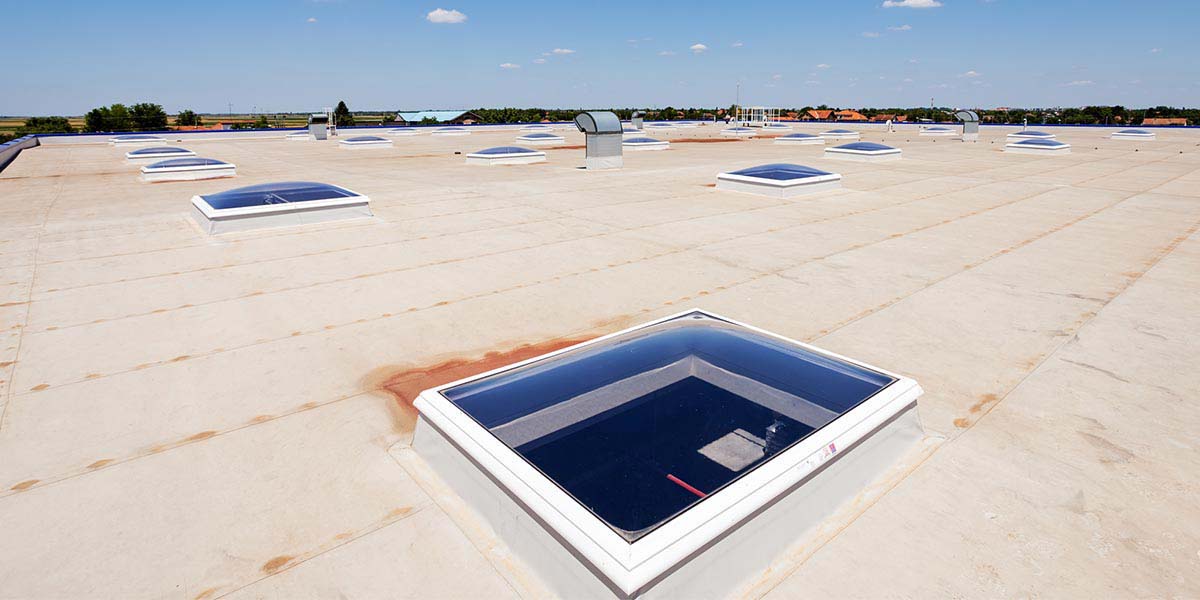
Modern businesses often look for eco-friendly options as they construct a new space or remodel parts of their building. A roof that saves energy and contributes to a greener environment is frequently a top item on the list. We’ve rounded up the top sustainable roofing solutions your eco-savvy customers are looking for.
To determine whether or not a roof is sustainable, you have to look at what it’s made of. Green roofing materials should be energy-efficient, durable and a candidate for responsible disposal at the end of its use. From solar panels to rubber roofs, we’ll take an in-depth look at which materials fit the mold.
Here are six eco-friendly roofing materials you can suggest for sustainable building projects.
Metal roofs include a variety of materials, like aluminum, steel, copper, zinc and tin. These panels are usually made of recycled elements, like used beverage cans.
According to a study funded by the U.S. Department of Energy and conducted by the Oak Ridge National Laboratory, metal roofs promote energy conservation because they require good ventilation. As a heat conductor, if the metal isn’t properly insulated the building will get too hot inside.
A batten system is typically used during installation, which leaves a space underneath the metal and above the sheathing to allow airflow. This prevents heat from escaping through the top of the building and helps to regulate temperature.
According to the Study: Metal roofs with proper ventilation showed a 25% reduction in cooling costs and 45% reduction in heat flow.
TPO is a popular roofing material for commercial buildings because it’s durable, flexible and chemical- and UV light-resistant. Its flexibility makes it easy for commercial roofing contractors to mold it to unique roof designs. Because of its resistance to chemicals like fats and oils, it’s a common choice for restaurants and other businesses that release these substances through their ventilation systems.
TPO’s light color reflects heat away from the building, which helps the business inside conserve energy. This is known as cool roofing.
Pro-Tip: Cool roofing is a term that encompasses a variety of roofing products that are used primarily to reduce roof temperatures, thereby curtailing utility bills and reducing the environmental impact of cooling systems, and minimize urban heat islands as cool roofing reduces the amount of heat that would normally be trapped in a densely built area.
Rubber roofs are often made from recycled tires. They were developed with the goal of reducing the number of scrap tires sent to landfills, making them a very sustainable roofing solution. Plus, they can be recycled again and the end of their lifetime.
This recycled roofing material reflects the sun’s heat, making rubber an energy-efficient and cost-saving choice. The building will need less air to cool off and it also insulates by trapping heat to reduce energy costs in the colder months.
Ethylene propylene diene methylene (EPDM) is a synthetic rubber that is used on a lot of flat and low-sloped commercial roofs because of its resistance to sunlight and ozone, which can crack and wear away the material. It’s also versatile and easy to install and maintain. It comes in either black, a good choice to absorb heat in cooler climates, or white, a cooling roof option for warmer weather.
Did You Know: Incorporating recycled materials into roofing has become an important means of making the roofing industry more sustainable. For instance, builders in the US can receive LEED certification for incorporating recycled materials into their construction projects, which qualifies them for financial incentives that can reduce the overall cost of these projects.
The Freedonia Group
SPF is an eco-friendly roofing option that is sprayed as a liquid but expands into a foam, creating a solid layer across an existing roof. This is a common choice for commercial, industrial and manufacturing facilities.
Because it can be used on top of the original roof, less waste is created to use this technology. The materials used to make SPF are also environmentally friendly. Plus, it has a high R-value, meaning it has an increased ability to resist conductive heat transfer, saving energy. It also comes in white, which means it can be a cooling roof.
Also called living roofs, green roofs rank high on the sustainability scale because they incorporate vegetation and contribute to the growth of natural resources. Not to mention, they improve air quality.
Being covered partially or completely by plants and grass, a big advantage to this sustainable roof system is its ability to protect commercial buildings by absorbing water runoff and heat. The garden also acts as natural insulation, lowering the energy costs of the building it sits on.
Did You Know: Green roofs are a growing trend for businesses, not just for their environmental benefits, but also for tax incentives. Many areas provide financial incentives for installing living roofs.
While they do require ongoing maintenance, if you have access to the roof, these can be a nice escape from indoors.
Solar roofing is sustainable because it produces its own energy from the sun. This can save companies a lot of money each month on electricity. According to an EnergySage market data report, the average commercial property owner paid $1,950 a month on electric before installing solar panels. The bill went down to $500 when they used solar energy, a 75% difference.
Solar panels usually last about 25-30 years at full capacity before their energy production begins to decline. However, as long as they’re kept in good shape, they can continue to work for decades. When they finally do need to be replaced, the old solar panels should be recycled to avoid sending harmful metals to the landfill.
Many of the sustainable roofing solutions listed above can be recycled at the end of their lifespan. Some even come from recycled materials. But if you’re tearing off a roof to replace it with one of these options, what do you do with the old materials?
Shingle recycling saves valuable resources. For example, recycling asphalt shingles, a common roofing material, can be reused in pavement for new roads and similar projects, counteracting the need for new asphalt.
Renting a dumpster is a common and simple way to get rid of old roofing materials on the job site. We regularly work with roofing companies to provide the necessary resources to successfully recycle used materials. We also help companies implement zero waste initiatives with proper documentation required by clients to meet LEED standards.

“We provide containers for recycling depending on the material. We offer rebates, waste diversion reports and weight tickets. As long as you have the ability to separate the debris, it is not uncommon to have multiple containers on site for different types of materials.”
Jake Marimberga | Roofing Specialist and National Account Manager, Dumpsters.com
If you’re looking to start or expand your roofing company, consider adding these eco-friendly roofing materials to your services. It’ll give you a leg up in the industry, clean up the environment and qualify you for financial incentives so you can reduce the overall costs of your projects.
Want to learn more about the business? Learn how to bid a roofing job and avoid accidents while working with our roofing safety tips.